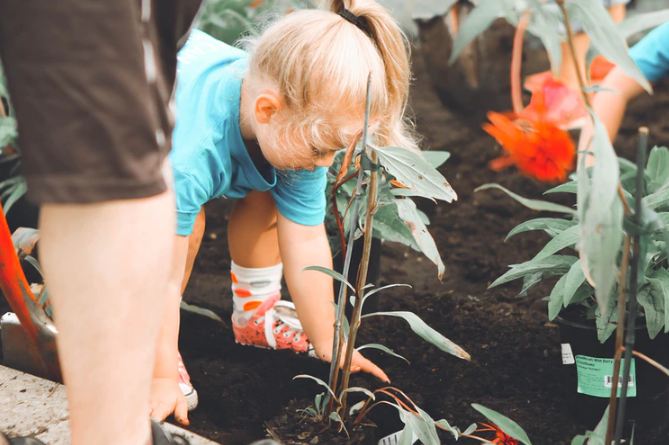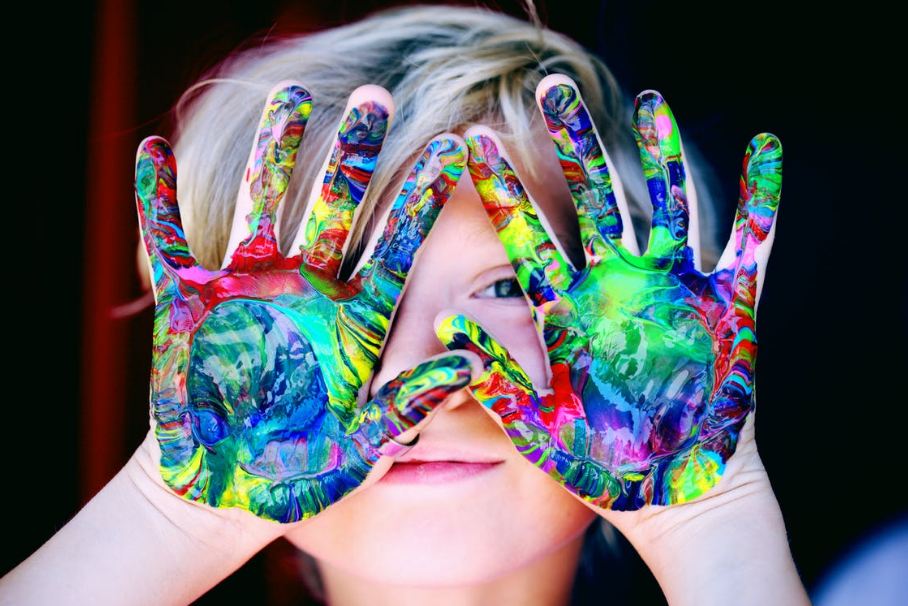Using Painting to Teach Shapes and Patterns to Kids
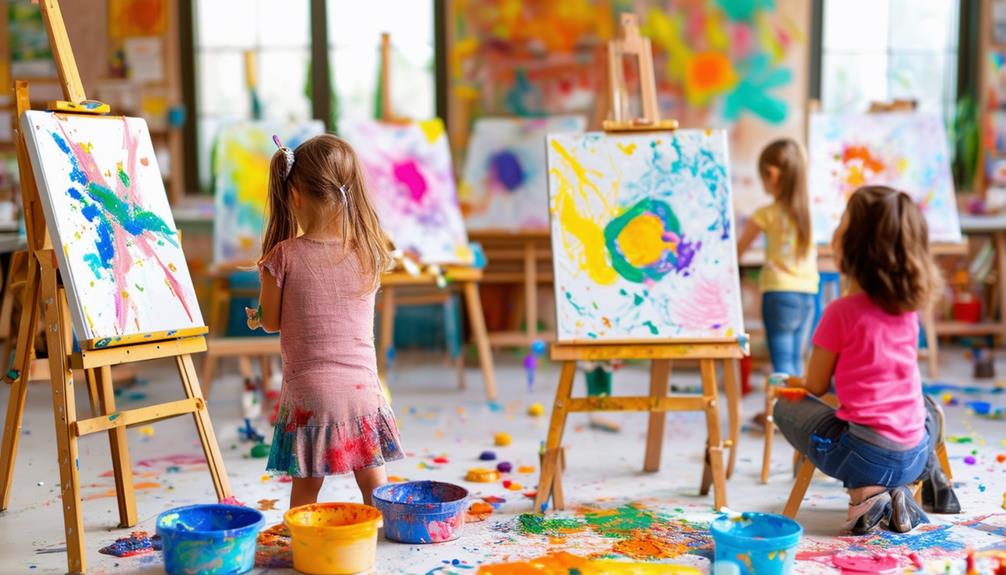
Introducing painting as a method to teach shapes and patterns to kids opens up a world of creative possibilities that enrich their cognitive and motor skills. By encouraging them to experiment with various brushes and techniques, they can grasp the concepts of symmetry and repetition through visual and tactile experiences. Guiding a child as they carefully paint stripes, polka dots, and zig-zags reinforces their understanding of patterns. This approach also serves as a gateway to exploring more intricate ideas. So, how can you effectively balance creativity and structure in these lessons?
The Joy of Painting Patterns
Exploring patterns through painting can transform a simple art project into an exciting learning experience for kids. By encouraging them to experiment with different patterns like stripes, polka dots, and zig-zags, you help them understand shapes, colors, and textures in a fun and creative way. Children love to see how various designs emerge when they paint, and this exploration fosters their imagination and artistic expression.
Next time you set up a painting session, provide a variety of brushes and techniques. Different brushes can create unique textures and designs, making the activity more engaging. For example, a sponge brush can produce interesting stippled effects, while a thin brush can be perfect for delicate stripes or intricate zig-zags.
Incorporating patterns into painting activities not only makes the artwork more varied and colorful but also improves fine motor skills and hand-eye coordination. As children carefully apply paint to create their desired designs, they hone these essential abilities. Give them the freedom to experiment and watch their creativity blossom. By emphasizing the joy of painting patterns, you set the stage for a richer, more dynamic learning experience.
Tracing and Sectioning Shapes
Tracing the outer edges of a hand with a thick black marker can help children understand shapes in a clear and engaging way. Once you have the hand tracing, you can divide the drawing into different sections. This technique allows for exciting pattern exploration and color variety. Here's how you can make it a fun learning experience:
- Divide the Hand: After tracing, draw lines inside the hand to create different sections. These divisions can be random or follow a specific pattern.
- Explore Patterns: Encourage children to fill each section with different patterns such as stripes, dots, zigzags, and more.
- Use Diverse Colors: Let children use a variety of colors within each section. This not only makes the activity visually appealing but also reinforces color recognition.
- Understand Spatial Awareness: Drawing patterns with spaces in between shapes helps children understand spatial relationships, enhancing their artistic skills and spatial awareness.
Shape experimentation and pattern exploration through hand tracing can be both educational and fun. Children will love the creativity involved and the opportunity to learn about shapes and colors in a hands-on way.
Exploring Pattern Varieties
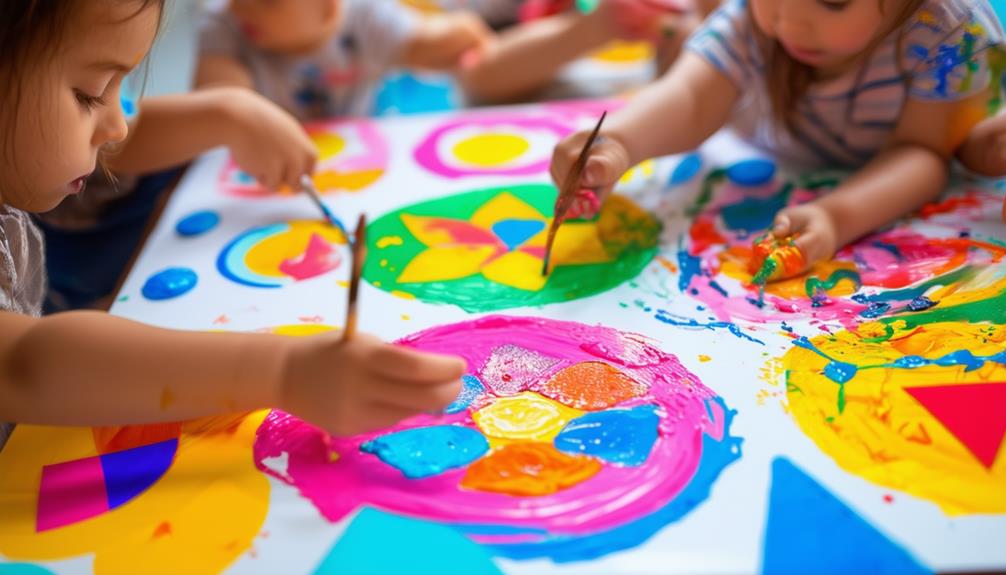
Now that the kids have traced and sectioned their shapes, let's encourage them to explore various patterns to enhance their creativity. Begin by introducing diverse pattern exploration techniques that allow for creative freedom. Demonstrate how to use shape combinations like leaves, squares, and wavy lines to create artistic expressions. As they experiment with these shapes, they will see how distinct patterns can emerge from the same basic elements.
Guide them in maintaining consistency in the size of shapes within each section to keep the patterns cohesive and visually appealing. Encourage them to leave spaces between shapes to teach balance and composition, which are essential for developing colorful patterns and imaginative designs.
Challenge the kids to try more intricate patterns, such as interlocking lines. This pushes them to think outside the box and experiment with more elaborate designs. By mixing simple and complex patterns, they will learn to appreciate the variety and depth that different patterns can offer.
Colorful Hand Patterns
Creating colorful hand patterns is a fantastic way for kids to learn about shapes and colors while having fun. Start by tracing your child's hand and dividing it into different sections. This simple step can lead to a variety of creative possibilities. Encourage them to fill each segment with colorful patterns, transforming an ordinary handprint into a vibrant canvas for artistic expression.
Here's how to get started:
- Rainbow Handprints: Use a variety of colors to create a rainbow effect, making each finger a different color or segmenting the hand into bands of color.
- Unique Designs: Experiment with different patterns like leaves, squares, and wavy lines. This not only teaches kids about shape variations but also helps them explore distinct designs.
- Intricate Handprint Art: Allow them to use their imagination to create detailed designs within their handprints. This fosters creative exploration and keeps them engaged.
- Balanced Patterns: Teach them to balance filled shapes with outlined patterns. Using contrasting colors can make the patterns stand out and help them understand the importance of consistency in design.
Adding final touches like tiny hearts or stars can enhance the overall design, teaching kids the importance of attention to detail in their artwork.
Experimenting With Shapes
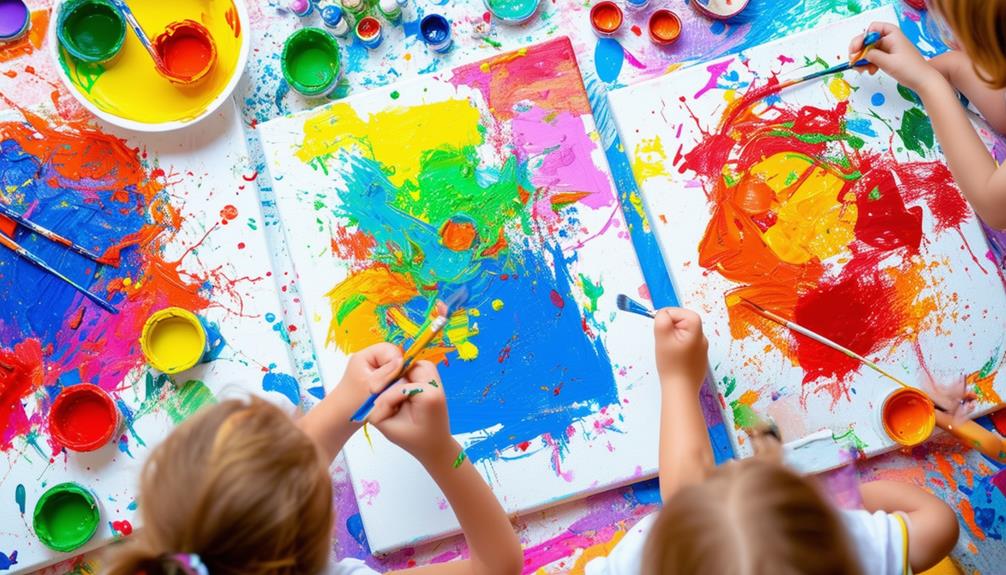
After mastering vibrant hand patterns, it's time to explore how experimenting with different shapes can enhance your child's artistic skills. Start by encouraging shape recognition and creative experimentation with basic forms like circles, triangles, and squares. These simple shapes are the building blocks of more intricate designs and can transform a blank canvas into a playground of geometric art and abstract compositions.
Begin with circle exploration. Let your child paint circles of varying sizes and colors, overlapping them to create a sense of depth and dimension. This exercise helps them understand spatial relationships and how altering the size of shapes can make their artwork stand out. Next, delve into triangle adventures. Show your child how combining and rotating triangles can create stars, mountains, or even abstract designs. This not only sparks their creativity but also improves their problem-solving skills as they figure out how to fit shapes together.
Encourage your child to repeat shapes to establish rhythm and unity in their paintings. This repetition can lead to captivating patterns and a cohesive look, teaching them the importance of consistency in art. By using a variety of shapes, your child can express their creativity and develop essential artistic skills.
Artistic Freedom in Painting
Encouraging artistic freedom in painting allows children to unleash their creativity without the constraints of strict guidelines. This approach not only fosters creative expression but also empowers kids to explore patterns and imaginative designs, thereby nurturing their personal style and self-confidence.
Four Ways to Promote Artistic Freedom in Painting:
- Provide Diverse Tools and Materials: Offer a variety of brushes, sponges, and textured items. This enables kids to experiment with different techniques, enriching their creative expression.
- Emphasize Autonomy: Let children choose their own colors, shapes, and patterns. This freedom encourages imaginative designs and personal investment in their artwork.
- Encourage Experimentation: Allow children to mix colors and try new brush strokes. This exploration helps them discover unique patterns and develop their personal style.
- Celebrate Individuality: Praise their unique creations and highlight the beauty of their original designs. Positive reinforcement strengthens their commitment to artistic freedom.
Techniques for Consistency

To help kids maintain consistency in their drawings, teach them to use the same colors strategically. Encourage them to balance patterns by mixing filled shapes with outlined ones, and ensure they vary shapes and colors so each part stands out clearly.
Consistent Color Strategy
Maintaining a consistent color strategy is essential for creating visually appealing and cohesive patterns in kids' artwork. By focusing on color coordination and effective painting techniques, you can guide kids to produce pieces that are not only beautiful but also well-organized. Here are some key strategies:
- Strategic Color Placement: Reuse the same colors in different sections of the painting to enhance pattern cohesion. This helps to unify different parts of the artwork.
- Appropriate Color Spacing: Position areas with the same color slightly apart to prevent patterns from blending together. This ensures that each element stands out clearly.
- Balancing Filled and Outlined Shapes: Combine filled shapes with outlined patterns to add depth and interest to the composition. This technique creates layers and dimension.
- Distinct Pattern Segments: Use color variation to ensure each part of the pattern stands out distinctly. This enhances the clarity and impact of the artwork.
Balanced Pattern Distribution
Achieving well-distributed patterns ensures each part of the artwork stands out distinctly and cohesively. Start by focusing on pattern spacing. By placing patterns with the same color slightly apart, you can prevent overcrowding, ensuring each section of the artwork remains distinct. This method not only avoids clutter but also enriches visual interest, encouraging kids to explore different sections of their creation.
Next, consider color arrangement. Strategically using the same color in diverse sections creates an artistic balance that ties the entire piece together. This approach helps maintain consistency without overwhelming any single area of the artwork.
Incorporating uniform shapes throughout the painting supports a balanced design. When shapes are evenly distributed, the eye naturally flows across the canvas, offering a harmonious viewing experience.
Remember to balance filled shapes with outlined patterns. This contrast ensures that each element stands out, adding depth and dimension to the artwork. Consistency and contrast between patterns will make each part of the painting unique yet cohesively integrated, fostering a balanced and engaging composition for young artists.
Distinct Shape Outlining
Consistent shape outlining aids children in quickly recognizing and distinguishing various patterns in their artwork. By maintaining uniformity, you enable them to enhance their shape recognition and artistic expression. Here's how to achieve this:
- Use the same color for similar shapes: Stick to one color for each category of shapes across different sections of the artwork. This assists with pattern distinction and reinforces uniformity.
- Space out identical shapes: Keep similar shapes slightly apart to enhance visual appeal and maintain engagement with the overall pattern.
- Balance filled and outlined shapes: Create a cohesive arrangement by mixing filled shapes with outlined ones. This sustains the visual interest of the artwork.
- Ensure clear patterns: Make sure each pattern is distinctly visible. This helps children understand shapes and patterns more effectively.
Consistent delineation doesn't limit creative freedom; instead, it provides a structured approach for children to explore artistic expression. By incorporating these methods, you nurture a deeper understanding of patterns and shapes, making their artwork not only visually appealing but also educational.
Adding Final Touches
When you're ready to add the final touches, consider incorporating heart patterns to enhance the visual appeal and cohesiveness of the artwork. Encourage kids to choose their own designs to make their creations unique and personal.
Adding Heart Patterns
Adding heart patterns as a final touch can significantly enhance your child's artwork. By carefully considering heart placement, color combinations, and creative variations, you can elevate a simple painting into a captivating masterpiece. Hearts can be drawn in various sizes and orientations, making them adaptable for different artistic styles. They not only enhance visual appeal but also introduce an emotional element, conveying love and warmth.
Here are some tips to get you started:
- Heart Placement: Position hearts thoughtfully among other patterns to create a balanced composition.
- Color Combinations: Use a diverse palette for the hearts to make the artwork vibrant and engaging.
- Creative Variations: Experiment with different sizes and orientations of hearts to add interest and depth.
- Emotional Impact: Incorporate hearts to convey emotions and enrich the overall feel of the artwork.
Teaching shapes and pattern recognition through hands-on learning with heart patterns can be both enjoyable and educational. By adding these final touches, you help your child develop artistic skills and create standout artwork.
Finishing With Style
Enhancing your child's artwork with final touches like stars and intricate patterns can significantly elevate their creation. By adding these enriching details, you not only complete the patterns but also showcase creativity that can make their work stand out. Save the most intricate details for this stage to create a visually appealing finish.
When adding final touches, encourage your child to think about what elements will add the most visual impact. It could be tiny stars filling the gaps between larger shapes or delicate, swirling lines that unify the composition. These final touches can transform a simple painting into a masterpiece, making the artwork look polished and thoughtfully completed.
Celebrate this moment by encouraging your child to share their finished piece with friends and family, spreading joy and inspiring others. This final step is about more than just completing patterns; it's about enjoying the process and the satisfaction it brings. Conclude your art session on a high note, celebrating the beauty of patterns and shapes. Your child's artwork, now adorned with these intricate details, will be a testament to their growing artistic skills and creativity.
Encouraging Creativity and Sharing
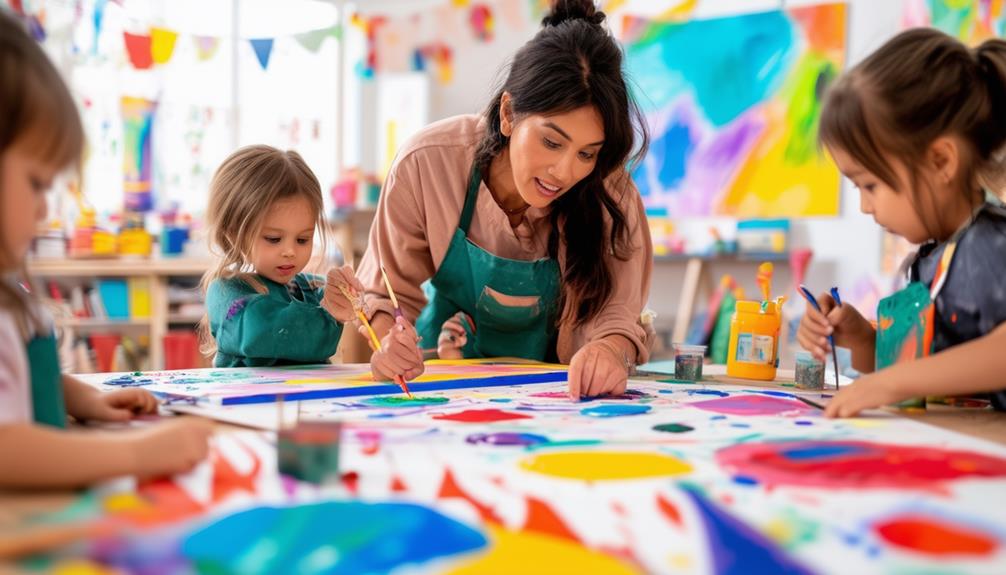
Encourage your kids to express their creativity by allowing them to paint their own unique patterns and shapes. This not only promotes self-expression but also fosters collaboration among peers. When children share their artwork, they build confidence and develop a sense of accomplishment. Here are some ways to encourage creativity and sharing:
- Art Sharing Sessions: Create a space where kids can display their paintings and discuss their unique patterns and shapes. This promotes self-expression and helps them appreciate each other's creativity.
- Collaborative Projects: Pair kids up to work on a larger painting. This fosters collaboration and teaches them to value each other's ideas and techniques.
- Art Appreciation Discussions: Engage children in conversations about the patterns and shapes they observe in their surroundings. This enriches their observational skills and sparks new ideas.
- Positive Feedback: Encourage kids to give and receive constructive feedback. This boosts confidence and helps them enhance their techniques.


